Local Service Business Lead Generation Benchmark Report 2020
As with everything else in the marketing field, the world of marketing for local service businesses is continually evolving. This makes it tough on marketers when they need to decide the best ways to invest their time and money.
Some classic tactics have grown out of date, while others remain evergreen. So, what are local service businesses doing when it comes to marketing? We created this report to help answer that question.
We, at Service Direct, surveyed over 250 local service businesses in the U.S. across home services, legal services, financial services, healthcare services and professional services industries.
Marketing Goals
Goals: Lead Generation Is By Far The Top Priority For 2020
Lead Generation remains the highest priority for local service businesses, followed by optimizing their sales and operations processes to win more of those leads in order to improve their Lead Close Rates. Customer Retention and Customer Upselling, both of which drive customer lifetime value, are the second highest priority, followed by Brand Awareness and Audience Engagement.
Lead Generation is of equal importance as a top marketing priority for each industry. Legal and Healthcare services industries are prioritizing Brand Awareness more than other industries. Financial Services companies place considerably more emphasis on Customer Retention than other industries. Home Services and Professional Services industries are prioritizing Lead Close Rate the most at 17%, compared to other industries at 8% on average.
.png?width=771&name=Top%20Marketing%20Priorities%2c%20All%20Industries%20(2).png)
.png?width=1046&name=Top%20Marketing%20Priorities%2c%20By%20Industry%20(1).png)
Lead generation Challenges
Challenges: Quality Is The Biggest Challenge When It Comes To Lead Generation
With Lead Generation as the top priority, we wanted to learn more about what the major challenges local service companies face when it comes to generating leads. The top challenge local service businesses are having when it comes to lead generation is the quality of leads, followed closely by the ability to turn more leads into customers. In other words, while they identify lead generation as their top marketing priority, getting quality leads is a bigger challenge than increasing the actual number of leads. Very few local service businesses feel like measuring ROI is a lead generation challenge.
All industries find increasing the volume of leads as a challenge, at 24% on average, apart from Legal Service providers at just 5%. This seems to indicate there is no shortage of legal leads available to them, but finding quality legal leads is a big challenge. Home Service businesses don’t consider proving marketing ROI a challenge (or they don’t care about it enough to be a challenge). Financial Services are most challenged by getting more leads and quality leads than other industries. This seems to indicate the Financial Services lead generation ecosystem is under-developed and is not addressing the lead generation challenges faced by providers in this industry.
.png?width=771&name=Top%20Lead%20Generation%20Challenges%2c%20All%20Industries%20(1).png)
.png?width=771&name=Top%20Lead%20Generation%20Challenges%2c%20By%20Industry%20(1).png)
Lead Generation Tactics
Tactics: Referrals/Word Of Mouth Are By Far The Most Effective Lead Generation Tactic
When is comes to generating leads, we wanted to learn more about what tactics local service businesses find most effective. And, if these tactics are online or offline.
Referrals/Word of Mouth are by far the most effective method for generating leads for local service businesses. The second most effective method is traditional offline marketing channels such as direct mailers, TV, and radio. When including other offline methods such as Trade shows, Newspaper Classifieds, and Door to Door Sales, it’s clear offline channels still play a massive role in helping local service businesses generate new customers. Despite the efficacy of PPC Advertising for many companies, by and large local service businesses don’t see it as an effective lead generation tactic.
Tactics: Social Media Is Considered The Most Effective Way To Generate Leads Online
When zooming in on just the digital/online tactics, most industries state Social Media as their most effective digital lead generation tactic. However, Legal Service businesses see little value in Social Media as a lead generation tactic. Webinars appear to be the most effective digital lead generation tactic for Legal Services.
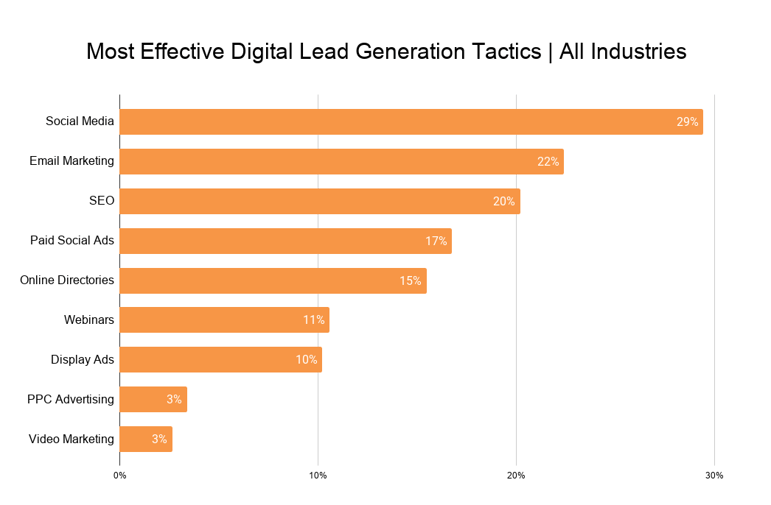
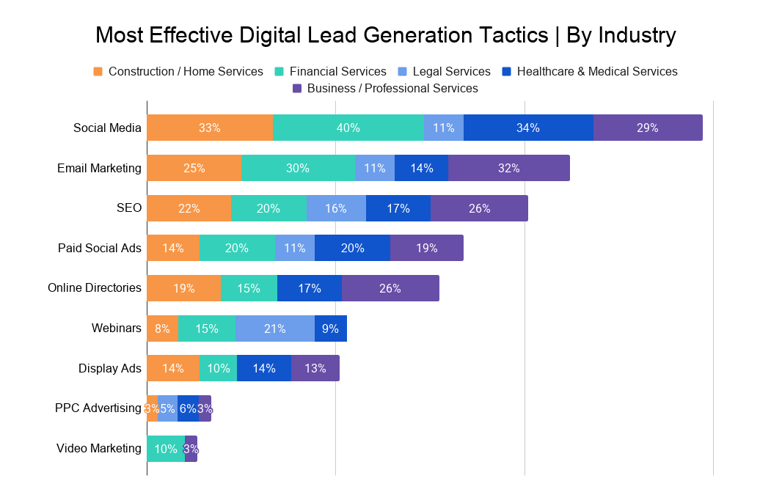
Tactics: Facebook Continues To Be The Most Active Social Network For Service Businesses
Facebook is the clear market leader when it comes to Social Media channels utilized by local service businesses, followed by Linkedin and Twitter. Not surprisingly, LinkedIn plays an outsized role for white-collar industries like Financial and Legal Services.
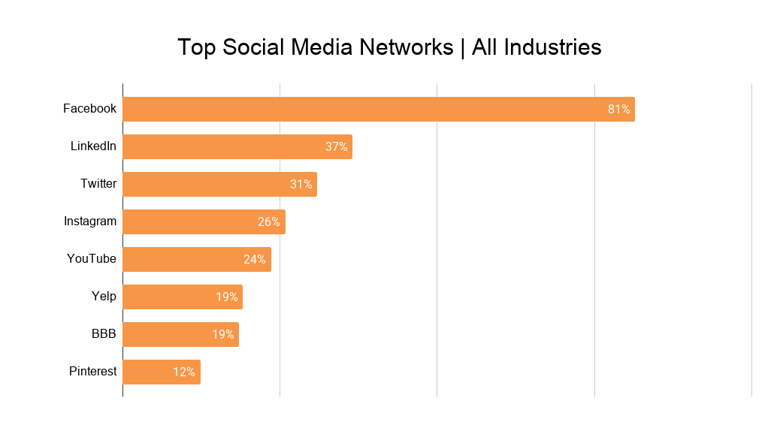
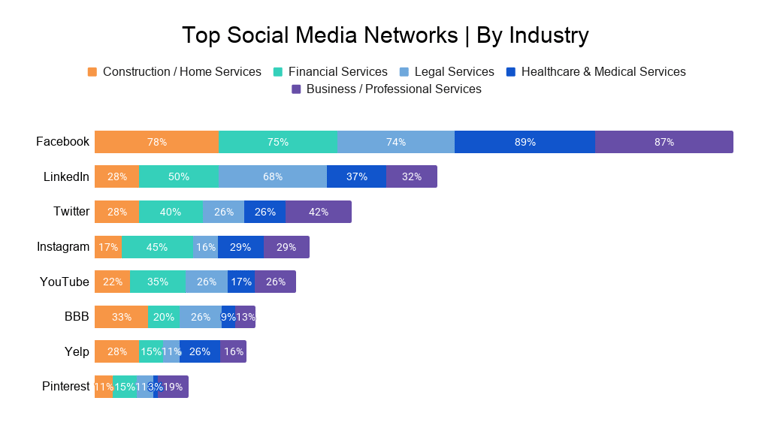
Marketing Resources
Resources: Majority Of Local Service Businesses Spend Less Than $2,000 Per Month On Marketing
The majority of local service businesses spend less than $2,000 per month marketing their business, with almost 40% spending less than $850 per month.
When looking at marketing budget by industry, 81% of Home Service businesses spend less than $2,000 per month in marketing their business, with 56% spending less than $850 per month (or $10,000 annually).
And, 68% Business/Professional Services spend less than $850 per month (or $10,000 annually), representing the industry that devotes the least amount of financial resources to marketing in order to attract new customers.
.png?width=771&name=Annual%20Marketing%20Budget%2c%20All%20Industries%20(1).png)
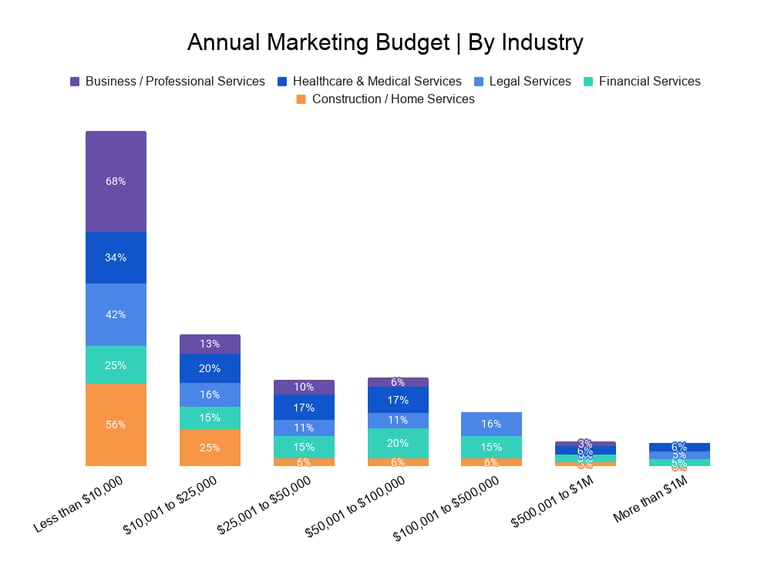
Resources: Majority Of Local Service Businesses Spend Their Budget On Offline Advertising
Despite the explosion in popularity of digital media, Offline Advertising still garners the largest amount of budget allocation for local service businesses, followed by their website and digital advertising to their website. Very few local service businesses allocate budget to SEO to their website.
.png?width=994&name=Marketing%20Budget%20Allocation%2c%20All%20Industries%20(2).png)
Resources: Majority Of Local Service Businesses Use Manual Methods For Managing Leads
Less than 1 in 5 local service businesses utilizes software to manage their leads/customers. In fact, 60% still use either pen/paper or a spreadsheet. Marketing Automation Software plays an outsized role for Financial Services versus other industries. However, when looking at the industry breakdown, Financial Service businesses are adopting marketing automation software over the other industries.
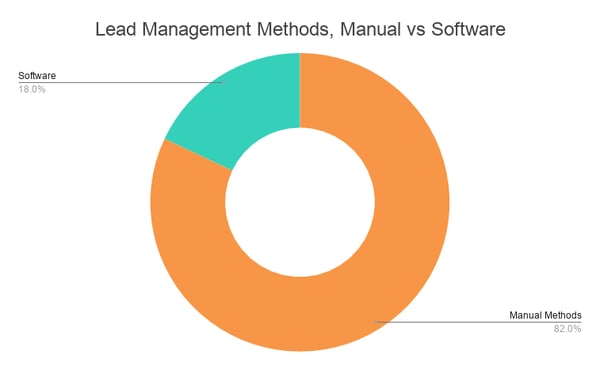
.png?width=994&name=Lead%20Management%20Methods%2c%20All%20Industries%20(1).png)
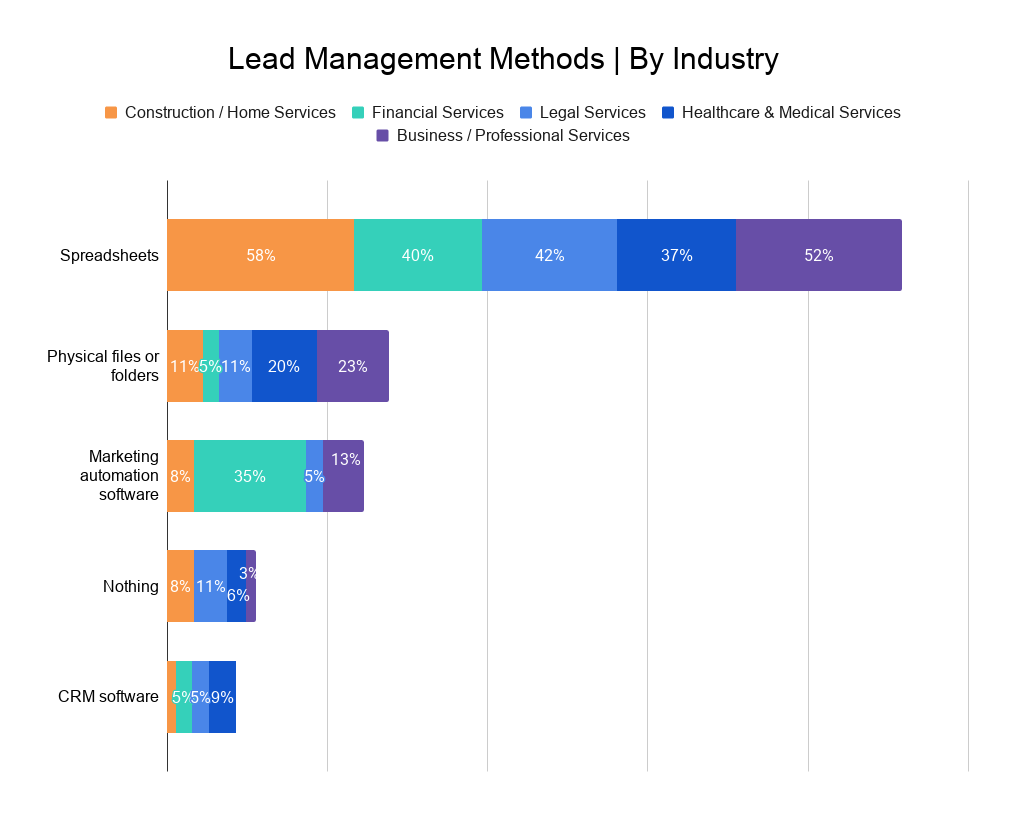


.png?width=771&name=Most%20Effective%20Lead%20Generation%20Tactics%2c%20All%20Industries%20(1).png)
